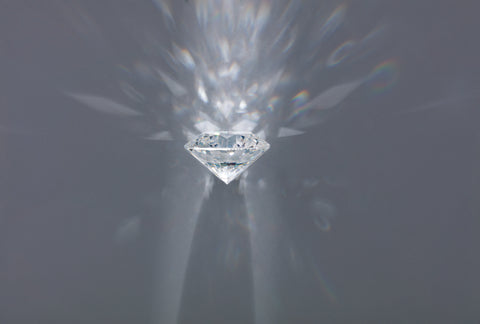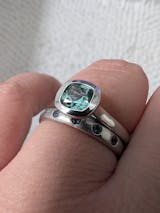So you've decided to take the next big step in your relationship and propose with a diamond engagement ring. Congratulations! Choosing the perfect diamond can be an exciting yet overwhelming task. With so many options available, it's important to understand the basics before making your final decision. In this article, we will guide you through the process of selecting a diamond that will truly dazzle your partner or be a perfect treat for your big accomplishments.
When it comes to diamonds, there is a world of fascinating information to explore. Let's dive deeper into the four most important factors to consider when evaluating a diamond: cut, clarity, carat, and color.
The cut of a diamond refers to how well it has been shaped and proportioned. This factor plays a crucial role in determining the diamond's overall look, brilliance and sparkle. A well-cut diamond will reflect light in a way that enhances its beauty and even makes it look bigger, while a poorly cut diamond may appear dull and lifeless. In my personal opinion this is the most important factor that sets a stunning diamond apart from a not so great looking diamond.
Clarity is another essential aspect to consider. It refers to the presence of any internal or external flaws, known as inclusions and blemishes, respectively. The fewer imperfections a diamond has, the higher its clarity grade will be. Diamonds with higher clarity grades are rarer and more valuable but also get expensive quickly. Your aim when purchasing a diamond should be to find a stone that is eye-clean, meaning it doesn't have any imperfections visible to the naked eye, and many VS2 diamonds pass as eye-clean. Even many SI1 diamonds may still be eye-clean depending on where the inclusion is located within the diamond. Inclusions are also easier to spot in a step cut emerald diamond than in a more faceted diamond like a round brilliant cut where inclusion get lost within all the sparkle and reflections. The bigger a diamond, the easier it is to see any inclusions.
- FL - Flawless: No internal or external clarity characteristics
- IF- Internally Flawless: No internal clarity characteristics
- VS1, VS2 - Very Slightly Included: Inclusions not typically visible to the unaided eye
- SI1, SI2 -Slightly Included: Visible under 10X magnification and may be visible to the unaided eye
- I1, I2, I3 - Included: Inclusions visible to the unaided eye
Diamond Carat
Carat is a measurement of a diamond's weight. One carat is equivalent to 200 milligrams, and larger carat weights are generally more valuable. You may also hear the weight of a diamond referred to in points. One carat is equivalent to 100 points, so a 75-point diamond is equal to 0.75 carats. Keep in mind that carat weight solely indicates the mass of a diamond, while size pertains to its physical dimensions. A deeper cut diamond has a lot of it's weight hidden in the lower belly and will look smaller from the top than a diamond with better proportions. As a result, two diamonds with identical carat weights may exhibit varying sizes due to differences in their dimensions.Conversely, diamonds may share the same diameter or depth, yet their carat weights can differ. However, it's important to note that carat weight alone does not determine a diamond's worth. The other three C's also play significant roles in determining its overall value.
Diamond Color
Color grading is an essential factor in diamond evaluation. The Gemological Institute of America (GIA) grades diamonds on a scale from D (colorless) to Z (light yellow or brown). Colorless diamonds are the most sought after due to their rarity. The presence of color can affect a diamond's cost, so it's crucial to consider this aspect when making a purchase.

Keep in mind that the metal color of the ring setting also impacts how the diamonds color is perceived. In a yellow gold of rose gold setting, a diamond will always appear warmer than in a white gold or platinum setting due to the reflections of the metal in the diamond.

Oval diamond engagement ring in Nodeform's Signature Platinum ring setting
Diamond Shapes and Their Meanings
Did you know that diamonds come in various shapes, each carrying its own symbolic meaning? The shape of a diamond can express different emotions and reflect the wearer's personality. Let's explore some popular diamond shapes and their significance.

Round diamonds
Round diamonds are classic and timeless. They are the most popular choice for engagement rings, symbolizing eternal love and commitment. Their symmetrical shape maximizes light reflection, resulting in exceptional brilliance.
Mixed Metal Round 0.55ct Diamond Rose gold Bezel Platinum Engagement Ring
Princess-cut diamonds
Princess-cut diamonds, on the other hand, are known for their modern elegance. With their square or rectangular shape and brilliant faceting, they exude sophistication and contemporary style.

Cushion-cut diamonds
Cushion-cut diamonds are a soft rectangular, or square diamond with rounded edges. A cushion cut diamond complements the shape with softened corners, giving it a pillow-like look, hence the term “cushion cut. There are two main cut styles and dozens of different proportions, which leads to endless - sometimes overwhelming - variation. With their square or rectangular shape and brilliant faceting, they are pleasing to the eye and have a more cozy appearance.

0.5ct rectangle cushion cut diamond engagement ring in platinum
Oval-shaped diamonds
If you're looking for something unique, consider oval-shaped diamonds. These elongated, rounded diamonds offer a flattering and feminine look. They are perfect for those who appreciate a blend of classic and modern aesthetics.
Emerald vs Radiant-shaped diamonds
Emerald-cut diamonds are characterized by their rectangular shape and step-cut faceting. This shape showcases the diamond's clarity and creates a mesmerizing hall-of-mirrors effect. It is a popular choice for those seeking a vintage-inspired look. The Radiant cut diamond does have a similar shape as the emerald cut diamond but different faceting that makes them more sparkly.

Pear-shaped diamonds
Pear-shaped diamonds, also known as teardrop diamonds, are a symbol of elegance and grace. Their combination of a rounded bottom and a pointed top creates a distinctive and eye-catching look.

Marquise-shaped diamonds
Marquise diamonds, with their distinctive eye-like shape, possess one of the largest surface areas among all diamond shapes making them look bigger than other shapes with the same weight.

Brooklynn engagement ring with bezel set marquise lab grown diamond
When choosing the shape of a diamond, it's essential to consider your partner's personality and preferences. Each shape carries its own charm and meaning, so take the time to find the one that resonates with your loved one.
The Appeal of Rose Cut Diamonds
If you prefer a more Art-Deco look a rose cut diamond can also fit the bill and be a different look to the more traditional diamond cutting. Rose cut diamonds can come in many shapes, although the round rose cut is the most common. Their triangular facets at the top and low profile design makes them an interesting choice if you prefer a little different look.

Round Rose Cut Diamond Low Profile Bezel Solitaire Engagement Ring with Curved black Diamond Petal Band
Natural vs. Lab-Grown Diamonds
In recent years, lab-grown diamonds have gained popularity for their ethical and sustainable properties. These diamonds are created in a controlled environment using advanced technology that replicates the natural diamond-growing process. They have the same physical and chemical characteristics as natural diamonds but are typically more affordable.
While natural diamonds are formed deep within the Earth over millions of years, lab-grown diamonds are created in a matter of weeks. This difference in origin has sparked a debate among consumers. Some prefer the allure and mystique of natural diamonds, while others appreciate the eco-friendly and conflict-free nature of lab-grown diamonds.
When deciding between natural and lab-grown diamonds, it's essential to consider the advantages and disadvantages of each type. Natural diamonds have a timeless appeal and are often considered a symbol of luxury. On the other hand, lab-grown diamonds offer a more affordable and sustainable option without compromising on beauty and quality.
Ultimately, the choice between natural and lab-grown diamonds depends on your personal values and preferences. Both options have their merits, and it's important to make an informed decision that aligns with your beliefs.There is no visual difference in appearance between a lab grown or a mined diamond.

Setting Your Budget for a Diamond Ring
Determining What You Can Afford
Before diving into the world of diamond shopping, it's essential to set a budget. Analyze your current financial situation and determine the maximum amount you are willing to spend on an diamond engagement ring. Remember, the cost of a diamond can vary significantly depending on its quality and characteristics. Making small cuts on certain properties can yield huge savings.
The Price Range for Different Diamond Sizes and Qualities
It's important to have a general idea of the price range for diamonds of different sizes and qualities. Smaller diamonds with lower quality ratings are generally more affordable, while larger diamonds with higher quality ratings command a higher price. Understand these price variations to make an informed decision.

Customizing Your Diamond Engagement Ring
Selecting the Perfect Ring Setting
The setting of the diamond engagement ring plays a significant role in its overall appearance. Popular setting styles include prong, bezel, and halo. Each setting has its own aesthetic and practical considerations. Think about your partner's taste and lifestyle when choosing the perfect setting.
Shop Our Ring Settings to Create your Perfect Diamond Ring
Choosing the Metal for Your Ring
The metal choice for your engagement ring should complement the diamond and match your partner's style. Common options include platinum, white gold, yellow gold, and rose gold. Consider factors such as durability, maintenance, and personal preference to make the right choice.

Learn More about the metals use in Nodeform Rings
Making the Final Decision
Balancing Quality and Cost
When choosing a diamond, it's crucial to strike a balance between quality and cost. You want to find a diamond that meets your desired specifications while staying within your budget. Consider prioritizing the four C's based on your partner's preferences to find the perfect combination.
Ensuring the Ring Matches Your Partner's Style
Remember, the engagement ring is a symbol of your love and commitment. Make sure the design and style of the ring reflect your partner's taste and personality. If in doubt, discreetly gather input from their friends or family members to ensure a perfect match.

Confirming Your Diamond's Authenticity
Once you have made your decision and purchased the diamond engagement ring, it's essential to confirm its authenticity. Keep all relevant documentation and certifications that come with the diamond. Consider getting an appraisal from an certified gemologist to document the value and use it to insure the ring.
Choosing a diamond for an engagement ring is an exciting journey that requires thoughtful consideration. By understanding the basics, setting a budget, choosing a trusted retailer, customizing the ring, and making the final decision with confidence, you will find the perfect diamond that symbolizes your love and commitment. Good luck on your journey to finding the diamond of your dreams!

3-stone Tracy engagement ring with emerald cut diamond center and round side stones and accented knife edge mens wedding band

































